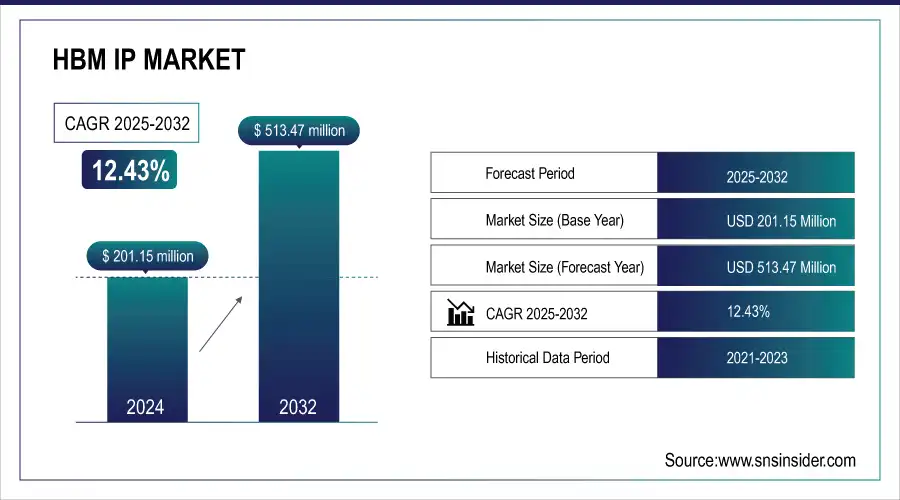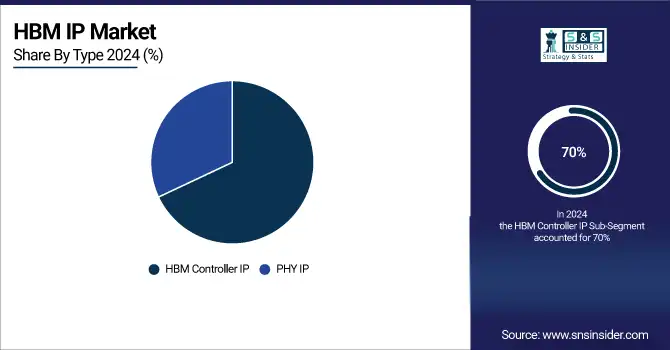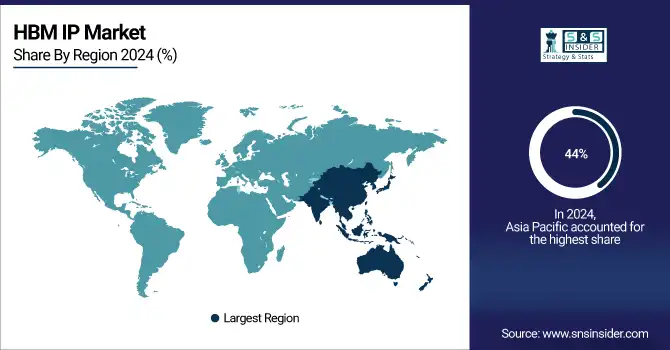HBM IP Market Size & Trends:
The HBM IP Market size was valued at USD 201.15 Million in 2024 and is projected to reach USD 513.47 Million by 2032, growing at a CAGR of 12.43% during 2025-2032.
The HBM IP market is experiencing a high growth due to the rising need for HPC, AI, and data center applications. HBM technologies, such as HBM2E and the upcoming HBM3E, enable high bandwidth and energy efficiency, which is crucial for applications with huge amounts of data movement, like AI and machine learning. The market is projected to grow further as memory performance is improved to accommodate the increasing requirement of data hungry workloads by industries. Furthermore, increasing deployment of advanced semiconductor manufacturing processes is further boosting the implementation of HBM IP into next-gen systems. The HBM IP market trends is expected to expand largely owing to the continuous development of memory technologies.

To Get more information On HBM IP Market - Request Free Sample Report
HBM IP Market Size and Forecast:
-
Market Size in 2024: USD 201.15 Million
-
Market Size by 2032: USD 513.47 Million
-
CAGR: 12.43% from 2025 to 2032
-
Base Year: 2024
-
Forecast Period: 2025–2032
-
Historical Data: 2021–2023
Key trends in the HBM IP Market:
-
Rising demand for high-speed memory in AI, HPC, and data-intensive workloads.
-
Increasing adoption of heterogeneous chip architectures in advanced computing.
-
Growing need for power-efficient memory solutions in semiconductor designs.
-
Rapid scaling of AI accelerators and GPU-driven computing ecosystems.
-
Expansion of 2.5D/3D IC packaging technologies integrating HBM stacks.
-
Higher investment in advanced memory IP by fabless and system-on-chip developers.
-
Strategic licensing collaborations between IP vendors and semiconductor firms.
Global Unichip Corp. (GUC) recently announced the adoption of its 3nm HBM3E Controller and PHY IP by a leading Cloud Service Provider (CSP) and several High-Performance Computing (HPC) solution providers. This cutting-edge ASIC, featuring the latest 9.2Gbps HBM3E memory technology, is set to tape out in 2024.
The U.S HBM IP market size was valued at USD 34.95 Million in 2024 and is projected to reach USD 90.49 Million by 2032, growing at a CAGR of 12.62%, driven by the rising demand for high-performance computing, AI, and data-intensive applications. Increasing adoption in data centers and GPUs, along with advancements in 3D-stacked memory technology, further fuels market growth, enabling faster data processing and energy-efficient memory solutions across industries.

HBM IP Market Drivers:
-
Increasing Demand for High-Bandwidth Memory in AI and HPC
Lower power and high-performance computing (HPC) and artificial intelligence (AI) are the increasing demands is a significant driver of the HBM IP market. In addition, with the evolution of AI workloads such as deep learning, big-data analytics, real time processing etc., there is greater need for more performant and faster memory technologies. High Bandwidth Memory (HBM) provides the necessary speed and capacity to support such data-intensive workloads with low latency. Furthermore, the surge of data centers and cloud computing, which require high-speed memory to work efficiently, is driving the demand for HBM-based products rapidly. These factors, in addition to the continuous developments in HBM-based solutions, are accelerating the HBM IP market growth.
Cadence Design announced its industry's fastest HBM4 12.8Gbps memory IP solution, offering double the bandwidth compared to HBM3E and 20% greater power efficiency. This solution is designed for AI training and HPC hardware systems, available for customer engagements with TSMC's N3 and N2 technology nodes.
HBM IP Market Restraints:
-
Integrating HBM IP into Semiconductor Systems Design and Expertise Requirements
High Bandwidth Memory (HBM) IP faces strenuous restrictions to be integrated into a semiconductor system (System-on-Chip; SoC) because of complex design leeway. HBM technology demand special memory subsystem that are distinct from conventional memory architectures, posing technical challenges in their integration. It involves paying close attention to issues including signal integrity, power management, interposer design, and the like, all requiring expertise in advanced packaging and system architecture. Furthermore, close coupling between memory and processor units makes the integration even more difficult. They frequently encounter these difficulties with long development cycles, high costs and errors in the integration. This makes deployment not only slow due to the demand on trained engineers, complex tools and extensive validation but high risk for delayed deployment.
HBM IP Market Opportunities:
-
Increasing Need for HBM IP Drives Growth in AI and High-Performance Computing Sectors
There is an accelerating demand for High-Bandwidth Memory (HBM) IP as specs increase and industries shift to the latest computing technologies, such as AI / deep learning, HPC and the gaming market. HBM IP brings valuable advantages including high memory bandwidth, low latency, and high performance, which are crucial for processing of big data and intensive computing. As the demand for higher speeds and increased efficiency from AI accelerators, GPUs, and advanced computing applications continues to rise, HBMIP offerings. Vendors of advanced HBM IP, particularly suppliers of pre-qualified memory controllers and PHYs, are well poised to capitalize on this increasing market and serve an industry that continues to adapt to new requirements.
Rambus has launched the industry’s first HBM4 Memory Controller IP, offering over double the throughput of HBM3 to meet the demands of AI and HPC workloads. This new controller supports up to 10 Gbps, delivering 2.56 Terabytes per second of bandwidth for next-gen processors and accelerators.
HBM IP Market Challenges:
-
Integration Challenges of HBM IP with Emerging Technologies like AI, Quantum Computing, and 5G
High Bandwidth Memory (HBM) IP solutions face distinct challenges when the technologies that enable them, such as artificial intelligence (AI), quantum computing, 5G networks and more, evolve at a breakneck pace. These advanced technologies require high performance memory solutions with the capability to scale and easily integrate into more systems that are complicated. Additionally, the ability to have HBM IP that can be tuned to these unique application areas (e.g., super low latency, super high throughput, ultra-low-power, etc.) is still a work in progress. Furthermore, there is also the issue of interoperation of different types of hardware and applications for the text to speech technology. With the continued rise of AI and quantum computing, plus 5G adoption, the demand for flexible, scalable, and future-proof memory solutions is more significant hat ever, creating a challenge for HBM IP suppliers to ensure their offerings remain aligned with customer requirements.
HBM IP Market Segmentation Analysis:
By Type, PHY IP Segment Dominates HBM IP Market with 70% Share in 2024, HBM Controller IP Segment to Record Fastest Growth with 14.05% CAGR
The PHY IP held a dominant HBM IP share of around 70% in 2024. Increasing usage of IoT in smart homes, healthcare, and industrial automation industries is expected to fuel growth of the fixed focus lens market. These are key lenses to enable the feature function of IoT devices, and to improve the image taking and processing capabilities. The increasing demand for improved IoT systems is also driving market growth.
The HBM Controller IP segment is expected to experience the fastest growth in the HBM IP market over 2025-2032 with CAGR 14.05%. Demand for faster memory solutions is being fueled by the rapid growth of AI, machine learning, and high-performance computing (HPC) applications. The HBM Controller IP market is growing based on products that demand lower I/O power combined with large bandwidth. This growth is driven by the growing demand for high performance, low latency memory controllers in advanced CPUs.

By Application, Servers Segment Dominates HBM IP Market with 55% Share in 2024, Internet Segment to Record Fastest Growth with 13.99% CAGR
The Servers held a dominant HBM IP share of around 55% in 2024. Servers is expected to dominate the HBM IP market due to growing demand for AI and data-centric applications in data centers. The next generation of server architectures require high-bandwidth, low-latency memory access to support data rates ranging from 2400Mbps to 3072Mbps as well as minimizing memory system power.
The Internet segment is expected to experience the fastest growth in the HBM IP market over 2025-2032 with CAGR 13.99%. The growing adoption of high-bandwidth memory solutions is triggering the growth of internet infrastructure supported by the surge in global data traffic, increasing internet penetration rate, and swarming number of IoT devices being interconnected in the coming years. HBM IP supports the fast and efficient execution needed to drive faster internet services, which mean improved data transfer rates and data processing features in the next generation digital networks.
HBM IP Market Regional Insights:
Asia-Pacific Dominates HBM IP Market in 2024
In 2024, Asia-Pacific commands an estimated 44% share of the HBM IP Market, driven by its robust semiconductor manufacturing hubs and rapid AI and data center growth. The region benefits from leading foundries like Taiwan’s TSMC and South Korea’s Samsung and SK Hynix, producing advanced memory chips and integrating HBM IP into next-gen products. Aggressive investments in AI applications and expanding data center infrastructures in China further amplify demand, making Asia-Pacific the focal point for innovation and adoption in the HBM IP market.
Taiwan and South Korea are the dominating countries in Asia-Pacific, housing the world's most advanced semiconductor foundries and leading chip design companies. These countries provide cutting-edge manufacturing technologies essential for HBM production. China is also a growing force, leveraging increasing AI and data center investments. Together, these nations drive market growth through innovation, supply chain strength, and technological leadership in high-bandwidth memory IP solutions.

Get Customized Report as per Your Business Requirement - Enquiry Now
North America is the Fastest-Growing Region in HBM IP Market in 2024
North America is projected to grow at an estimated CAGR of 13.71% in 2024, fueled by increasing investments in AI, HPC, and cloud data centers. The rising demand for high-performance computing and advanced memory technologies across industries accelerates market expansion.
The United States dominates North America’s HBM IP Market due to its mature semiconductor ecosystem, leadership in AI research, and extensive data center infrastructure. U.S. companies focus on innovation in 3D-stacked memory and scalable HBM architectures, integrating these into GPUs, AI accelerators, and HPC platforms. Strong capital investments and a supportive regulatory environment further cement its leadership in the North American HBM IP market.
Europe HBM IP Market Insights, 2024
Europe held a significant portion of the HBM IP market in 2024, driven by growing demand for AI and high-performance computing in automotive and industrial automation sectors. Strict regulatory frameworks and advanced manufacturing contribute to sustained growth. Germany leads Europe’s HBM IP market due to its powerful automotive industry, which requires high-bandwidth memory for real-time analytics, connected vehicle systems, and advanced driver-assistance systems (ADAS). The country’s emphasis on digital transformation and sustainability further propels its dominance within Europe.
Middle East & Africa and Latin America HBM IP Market Insights, 2024
In 2024, Middle East & Africa showed steady growth driven by urbanization, telecom infrastructure upgrades, and rising cloud service adoption. South Africa leads the region with increasing investments in smart technology infrastructure. Latin America also experienced growth, led by Brazil and Mexico through expanding data centers and government initiatives promoting digital transformation. Both regions are emerging markets for HBM IP, focusing on enhancing AI, telecom, and data center capabilities to support next-generation technology adoption.
HBM IP Market Key Players:
-
Synopsys
-
Cadence Design Systems
-
Rambus Inc.
-
Alphawave Semi
-
Arm Ltd.
-
Samsung Semiconductor (Memory Solutions / IP Licensing)
-
SK hynix (HBM Interface & IP solutions)
-
Micron Technology
-
Renesas Electronics
-
OpenFive (SiFive Business Unit)
-
eSilicon (An Inphi Company / Marvell)
-
Brite Semiconductor
-
Faraday Technology Corporation
-
Montage Technology
-
GUC (Global Unichip Corp)
-
Xilinx (AMD Adaptive & Embedded)
-
Intel (Programmable Solutions Group / IP Division)
-
Innosilicon
-
MosChip Technologies
-
Dolphin Design
Competitive Landscape of HBM IP Market:
Synopsys
Synopsys is a U.S.-based global leader in electronic design automation (EDA) and semiconductor IP solutions, offering high-bandwidth memory (HBM) IP for advanced computing, AI, and high-performance applications. The company specializes in PHY, controller, and memory interface IP designed to optimize bandwidth, reduce latency, and improve power efficiency in next-generation processors and accelerators. Its role in the HBM IP Market is vital, providing scalable, high-performance IP solutions that accelerate semiconductor development and enable efficient integration of high-speed memory systems.
-
In 2025, Synopsys introduced an advanced HBM2E/3 PHY IP platform supporting multi-channel high-bandwidth memory integration in AI accelerators and data center processors.
Cadence Design Systems
Cadence Design Systems is a U.S.-based leader in electronic design automation and semiconductor IP, delivering HBM IP solutions including memory controller, PHY, and interface IP for high-performance computing, AI, and data center applications. The company focuses on energy-efficient, low-latency, and high-bandwidth memory interfaces that enhance processor performance and scalability. Its role in the HBM IP Market is substantial, enabling chip designers to accelerate integration of next-generation memory systems while maintaining high reliability and performance.
-
In 2025, Cadence Design Systems unveiled a next-generation HBM3 memory controller IP optimized for AI and HPC workloads with improved bandwidth and reduced power consumption.
Rambus Inc.
Rambus Inc. is a U.S.-based technology company specializing in high-performance memory and interface IP, including HBM PHY and controller IP for AI, GPU, and data center applications. The company provides scalable memory solutions that deliver high bandwidth, low latency, and enhanced signal integrity. Its role in the HBM IP Market is significant, offering flexible and energy-efficient IP solutions that accelerate adoption of HBM in advanced computing architectures.
-
In 2025, Rambus Inc. launched a low-power HBM2/3 PHY IP portfolio designed for integration in AI accelerators and high-performance networking chips.
Alphawave Semi
Alphawave Semi is a Canada-based semiconductor IP provider, offering high-speed connectivity and HBM IP solutions for AI, HPC, and networking applications. The company specializes in high-bandwidth, low-latency memory interface IP, enabling efficient integration of HBM stacks in advanced chip designs. Its role in the HBM IP Market is critical, delivering energy-efficient, scalable IP that supports next-generation high-performance computing and AI-driven workloads.
-
In 2025, Alphawave Semi introduced a multi-channel HBM3 interface IP optimized for data center and AI accelerator platforms, providing high bandwidth and low latency.
| Report Attributes | Details |
|---|---|
| Market Size in 2024 | USD 201.15 Million |
| Market Size by 2032 | USD 513.47 Million |
| CAGR | CAGR of 12.43% From 2025 to 2032 |
| Base Year | 2024 |
| Forecast Period | 2025-2032 |
| Historical Data | 2021-2023 |
| Report Scope & Coverage | Market Size, Segments Analysis, Competitive Landscape, Regional Analysis, DROC & SWOT Analysis, Forecast Outlook |
| Key Segments | • By Type(PHY IP and HBM Controller IP) • By Application(Servers, Internet and Others) |
| Regional Analysis/Coverage | North America (US, Canada, Mexico), Europe (Germany, France, UK, Italy, Spain, Poland, Turkey, Rest of Europe), Asia Pacific (China, India, Japan, South Korea, Singapore, Australia, Taiwan, Rest of Asia Pacific), Middle East & Africa (UAE, Saudi Arabia, Qatar, South Africa, Rest of Middle East & Africa), Latin America (Brazil, Argentina, Rest of Latin America) |
| Company Profiles |
Synopsys, Cadence Design Systems, Rambus Inc., Alphawave Semi, Arm Ltd., Samsung Semiconductor (Memory Solutions / IP Licensing), SK hynix (HBM Interface & IP solutions), Micron Technology, Renesas Electronics, OpenFive (SiFive Business Unit), eSilicon (An Inphi Company / Marvell), Brite Semiconductor, Faraday Technology Corporation, Montage Technology, GUC (Global Unichip Corp), Xilinx (AMD Adaptive & Embedded), Intel (Programmable Solutions Group / IP Division), Innosilicon, MosChip Technologies, and Dolphin Design. |

